(https://houseofbhakti.com) – Why should Vaiṣṇavas observe Śiva-caturdaśī [Śiva-rātri] like Ekādaśī?
The following is an excerpt from the book Śrī Bhakti-rasāmṛta-sindhu-bindu (Third edition) by Śrīla Viśvanātha Cakravartī Ṭhākura (Translation into Hindi and commentary by Śrīla Bhaktivedānta Nārāyaṇa Mahārāja)
Verse 6 The Severity of Nāmāparādha
sarvāparādha-kṛd api mucyate hari-saṁśrayāt
harer apy aparādhān yaḥ kuryād dvipada-pāṁśanaḥ
nāmāsrayaḥ kadācit syāt taraty eva sa nāmataḥ
nāmno ’pi sarva-suhṛdo hy aparādhāt pataty adhaḥ
Śrī Bindu-vikāśinī-vṛtti
Sādhakas should remain thoroughly attentive to avoid committing all the offences mentioned in the previous section. Even a person who has committed all kinds of offences is redeemed by taking shelter at the lotus feet of Śrī Hari. If a most wretched and fallen person (a two-legged animal) who has committed severe offences at the feet of Śrī Hari ever takes shelter of the holy name of Śrī Hari, then the holy name alone mercifully delivers him from all such offences. There is no doubt of this whatsoever. Therefore śrī harināma is the best friend of all. But if one should commit an offence at the feet of śrī harināma his falldown is inevitable. The above two verses are quoted from Bhakti-rasāmṛta-sindhu (1.2.119–20).
Verse 7 – Nāma-aparādha
atha nāmāparādha daśa: yathā – vaiṣṇava-nindādi –
vaiṣnavāparādhaḥ; viṣṇu-śivayoḥ pṛthag-īśvara-buddhiḥ;
śrī-gurudeve manuṣya-buddhiḥ; veda-purāṇādi-śāstra-nindā;
nāmni arthavādaḥ; nāmni kuvyākhyā vā kaṣṭa-kalpanā;
nāma-balena pāpe pravṛttiḥ;
anya śubha-karmabhir nāma-sāmya-mananam;
aśraddha-jane nāmopadeśaḥ;
nāma māhātmye śrute ’pi aprītiḥ – iti daśadhā.
Śrī Bindu-vikāśinī-vṛtti
Ten kinds of nāmāparādha will now be described in connection with the chanting of the holy name of the Lord.
(1) To commit offences against the Vaiṣṇavas by slandering them and so on (nindādi). The word ādi here refers to the six kinds of vaiṣṇava-aparādha indicated in the following verse from the Skanda Purāṇa, quoted in Bhakti-sandarbha (Anuccheda 265):
hanti nindati vai dveṣṭi
vaiṣṇavān nābhinandati
krudhyate yāti no harṣaṁ
darśane patanāni ṣa
To beat Vaiṣṇavas, to slander them, to bear malice against them, to fail to welcome them, to become angry with them and to not feel happiness upon seeing them – by these six types of vaiṣṇava-aparādha one falls down to a degraded position.
(2) To consider Lord Śiva to be the Supreme Lord, separate and independent from Lord Viṣṇu.
(3) To consider Śrī Gurudeva to be an ordinary human being.
(4) To slander the Vedas, Purāṇas and other scriptures.
(5) To consider the praises of śrī harināma to be imaginary; in other words, to consider that the potencies which have been praised in the scriptures in reference to harināma are not actually present in the holy name.
(6) To give an unauthorised and misleading explanation of śrī harināma; in other words, to abandon the established and reputed meaning of the scriptures and foolishly concoct some futile explanation. For example, someone may argue that the Lord is incorporeal (nirākāra), formless (arūpa) and nameless (anāma) and that therefore His name is also imaginary.
(7) To engage in sinful activities again and again, knowing that there is such power in the holy name that simply by uttering śrī harināma all sins are vanquished.
(8) To consider all kinds of religious or pious activities to be equal to śrī harināma.
(9) To instruct faithless persons about śrī harināma.
(10) To not have love for the name in spite of hearing the glories of śrī nāma.
These ten offences must certainly be avoided. In the practice of hari-bhajana, one should first of all be very attentive to avoid all sevāparādhas and nāmāparādhas. One should know these aparādhas to be severe obstacles on the path of bhajana and vigorously endeavour to give them up. Without giving up these offences there can be no question of advancement in bhajana; rather, the sādhaka’s falldown is assured.
The sādhaka should also be vigilant not to commit any sevāparādhas in the matter of worship of the deity. Sevāparādhas that are committed unknowingly in the course of serving the deity are mitigated by wholehearted surrender unto Lord Hari, by offering prayers unto Him and, in particular, by taking shelter of śrī harināma. The holy name mercifully forgives all of one’s sevāparādhas. Śrī harināma is even more merciful than the deity. But if in spite of taking shelter of śrī harināma one is inattentive again in the matter of nāmāparādha, then his falldown is assured.

The following is an excerpt from Śrī Caitanya-caritāmṛta, Madhya-līlā by Śrīla Bhaktivedānta Svāmī Mahārāja Prabhupāda, Chapter Twenty-one, Verses 58–89
- “Actually it is very difficult to ascertain the number of universes. Every universe has its separate Lord Brahmā
 and Lord Śiva, who are known as permanent governors. Therefore there is also no counting them. “Once, when Kṛṣṇa was ruling Dvārakā, Lord Brahmā came to see Him, and the doorman immediately informed Lord Kṛṣṇa of Brahmā’s arrival. When Kṛṣṇa was so informed, He immediately asked the doorman, ‘Which Brahmā? What is his name?’ The doorman therefore returned and questioned Lord Brahmā. “When the doorman asked, ‘Which Brahmā?’ Lord Brahmā was surprised. He told the doorman, ‘Please go inform Lord Kṛṣṇa that I am the four-headed Brahmā who is the father of the four Kumāras.’ “The doorman then informed Lord Kṛṣṇa of Lord Brahmā’s description, and Lord Kṛṣṇa gave him permission to enter. The doorman escorted Lord Brahmā in, and as soon as Brahmā saw Lord Kṛṣṇa, he offered obeisances at His lotus feet. “After being worshipped by Lord Brahmā, Lord Kṛṣṇa also honoured him with suitable words. Then Lord Kṛṣṇa asked him, ‘Why have you come here?’
and Lord Śiva, who are known as permanent governors. Therefore there is also no counting them. “Once, when Kṛṣṇa was ruling Dvārakā, Lord Brahmā came to see Him, and the doorman immediately informed Lord Kṛṣṇa of Brahmā’s arrival. When Kṛṣṇa was so informed, He immediately asked the doorman, ‘Which Brahmā? What is his name?’ The doorman therefore returned and questioned Lord Brahmā. “When the doorman asked, ‘Which Brahmā?’ Lord Brahmā was surprised. He told the doorman, ‘Please go inform Lord Kṛṣṇa that I am the four-headed Brahmā who is the father of the four Kumāras.’ “The doorman then informed Lord Kṛṣṇa of Lord Brahmā’s description, and Lord Kṛṣṇa gave him permission to enter. The doorman escorted Lord Brahmā in, and as soon as Brahmā saw Lord Kṛṣṇa, he offered obeisances at His lotus feet. “After being worshipped by Lord Brahmā, Lord Kṛṣṇa also honoured him with suitable words. Then Lord Kṛṣṇa asked him, ‘Why have you come here?’ - “Being questioned, Lord Brahmā immediately replied, ‘Later I shall tell You why I have come. First of all there is a doubt in my mind which I wish You would kindly dissipate.
- “ ‘Why did you inquire which Brahmā had come to see You? What is the purpose of such an inquiry? Is there any other Brahmā besides me within this universe?’
- “Upon hearing this, Śrī Kṛṣṇa smiled and immediately meditated. Unlimited Brahmās arrived instantly. These Brahmās had different numbers of heads. Some had ten heads, some twenty, some a hundred, some a thousand, some ten thousand, some a hundred thousand, some ten million and others a hundred million. No one can count the number of faces they had. “There also arrived many Lord Śivas with various heads numbering one hundred thousand and ten million. Many Indras also arrived, and they had hundreds of thousands of eyes all over their bodies. “When the four-headed Brahmā of this universe saw all these opulences of Kṛṣṇa, he became very much bewildered and considered himself a rabbit among many elephants. “All the Brahmās who came to see Kṛṣṇa offered their respects at His lotus feet, and when they did this, their helmets touched His lotus feet. “No one can estimate the inconceivable potency of Kṛṣṇa. All the Brahmās who were there were resting in the one body of Kṛṣṇa. “When all the helmets struck together at Kṛṣṇa’s lotus feet, there was a tumultuous sound. It appeared that the helmets themselves were offering prayers unto Kṛṣṇa’s lotus feet. “With folded hands, all the Brahmās and Śivas began to offer prayers unto Lord Kṛṣṇa, saying, ‘O Lord, You have shown me a great favour. I have been able to see Your lotus feet.’
- “All of them then said, ‘It is my great fortune, Lord, that You have called me, thinking of me as Your servant. Now let me know what Your order is so that I may carry it on my heads.’
- “Lord Kṛṣṇa replied, ‘Since I wanted to see all of you together, I have called all of you here. “ ‘All of you should be happy. Is there any fear from the demons?’
- “ ‘Whatever burden was upon the earth You have taken away by descending to that planet.’
- “This is the proof of Dvārakā’s opulence: all the Brahmās thought, ‘Kṛṣṇa is now staying in my jurisdiction.’ “Thus the opulence of Dvārakā was perceived by each and every one of them. Although they were all assembled together, no one could see anyone but himself. Lord Kṛṣṇa then bade farewell to all the Brahmās there, and after offering their obeisances, they all returned to their respective homes. After observing all these opulences, the four-headed Brahmā of this universe was astonished. He again came before the lotus feet of Kṛṣṇa and offered Him obeisances.
- “Brahmā then said, ‘Whatever I formerly decided about my knowledge I have just now had personally verified. “ ‘There are people who say, “I know everything about Kṛṣṇa.” Let them think in that way. As far as I am concerned, I do not wish to speak very much about this matter. O my Lord, let me say this much. As far as Your opulences are concerned, they are all beyond the reach of my mind, body and words.’
- “Kṛṣṇa said, ‘Your particular universe has a diameter of four billion miles; therefore it is the smallest of all the
 universes. Consequently you have only four heads. “ ‘Some of the universes are one billion yojanas in diameter, some one trillion, some ten trillion and some one hundred trillion yojanas. Thus they are almost unlimited in area. “ ‘According to the size of the universe, there are so many heads on the body of Brahmā. In this way I maintain innumerable universes [brahmāṇḍas]. ‘No one can measure the length and breadth of the one-fourth of My energy manifested in the material world. Who then can measure the three-fourths that is manifested in the spiritual world?’ “ ‘Beyond the river Virajā is the spiritual nature, which is indestructible, eternal, inexhaustible and unlimited. It is the supreme abode, consisting of three-fourths of the Lord’s opulences. It is known as paravyoma, the spiritual sky.”’ “In this way Lord Kṛṣṇa bade farewell to the four-headed Brahmā of this universe. We may thus understand that no one can calculate the extent of Kṛṣṇa’s energies.
universes. Consequently you have only four heads. “ ‘Some of the universes are one billion yojanas in diameter, some one trillion, some ten trillion and some one hundred trillion yojanas. Thus they are almost unlimited in area. “ ‘According to the size of the universe, there are so many heads on the body of Brahmā. In this way I maintain innumerable universes [brahmāṇḍas]. ‘No one can measure the length and breadth of the one-fourth of My energy manifested in the material world. Who then can measure the three-fourths that is manifested in the spiritual world?’ “ ‘Beyond the river Virajā is the spiritual nature, which is indestructible, eternal, inexhaustible and unlimited. It is the supreme abode, consisting of three-fourths of the Lord’s opulences. It is known as paravyoma, the spiritual sky.”’ “In this way Lord Kṛṣṇa bade farewell to the four-headed Brahmā of this universe. We may thus understand that no one can calculate the extent of Kṛṣṇa’s energies.
*A yojana equals eight miles

An excerpt from a morning walk with Śrīla Bhaktivedānta Nārāyaṇa Mahārāja in Orlando, Florida, on May 28, 2010, published in Walking with a Saint – Morning Walks and Conversations 2010
Śrīpāda Āśrama Mahārāja: Sadāśiva’s abode is in Vaikuṇṭha, and Śambhu resides in Kailāśa. Are their abodes distinctly different?
And if so, where are they in relation to each other?
Śrīla Bhaktivedānta Nārāyaṇa Mahārāja: Kailāśa-pati (Śambhu, or Śiva) is a manifestation of Vaikuṇṭha-pati Sadāśiva.* They are not the same.
Vrajanātha dāsa: Kailāśa is not in Vaikuṇṭha?
Śrīpāda Āśrama Mahārāja: Those who worship Śambhu and go to Kailāśa – do they stay there eternally? 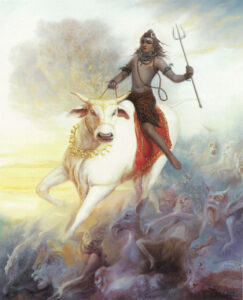
Śrīla Bhaktivedānta Nārāyaṇa Mahārāja: I have not seen this discussed in any scripture.
Śrīpāda Āśrama Mahārāja: I am asking because many Hindu people worship him.
Śrīla Bhaktivedānta Nārāyaṇa Mahārāja: Not so many. Very few persons worship Śambhu.**
Devotee: The consort of Śambhu in Kailāśa is Pārvatī. Is this eternal?
Śrīla Bhaktivedānta Nārāyaṇa Mahārāja: Yes.
Śrīpāda Āśrama Mahārāja: Sadāśiva and Lakṣmī are also eternal?
Śrīla Bhaktivedānta Nārāyaṇa Mahārāja: Yes.
* “According to the principle of philosophical truth (tattva), Lord Śiva is a partial manifestation of Śrī Kṛṣṇa’s plenary expansion, Sadāśiva. When Kṛṣṇa desires to create, He expands Himself as Mahā-Saṅkarṣaṇa, and possessing this creative desire, Saṅkarṣaṇa expands as Mahā-Viṣṇu (also known as Kāraṇodakaśāyī Viṣṇu or Sadāśiva). Mahā-Viṣṇu then desires to create, and His desire takes the form of a light that emanates from between his eyebrows. The semblance or dim twilight reflection of that light is called Śambhu-liṅga (Śiva)”
(Śiva-tattva, Chapter 3).
The respected reader is invited to read Śrīla Bhaktivedānta Nārāyaṇa Mahārāja’s Śiva-tattva for more information on this subject.
**Śrīla Bhaktivedānta Nārāyaṇa Mahārāja is saying that very few people worship Śambhu with the aim of attaining his association in Kailāśa. Most people worship him for material benefits.

The following is an excerpt from Śrīla Bhaktivedānta Nārāyaṇa Mahārāja’s letter to Dāmodara dāsa (The Netherlands), September 18 1997
Those who worship Śaṅkara, but being free from any worldly desires, attain Maheśa-dhāma [the abode of Maheśa]. There is no desire to serve Kṛṣṇa in their heart, but their worship is towards Śaṅkara and they have no material needs or desires. Also they live a pure life free from any sins and want to serve Śaṅkara. They cross Brahmaloka and become assistants of Śaṅkara.

An excerpt from a morning walk with Śrīla Bhaktivedānta Nārāyaṇa Mahārāja in Marina di Massa, Italy, on July 4, 2010, published in Walking with a Saint – Morning Walks and Conversations 2010
Devotee: Is it bona fide if someone in our saṅga has a śiva-liṅga inside the temple room next to the Deities?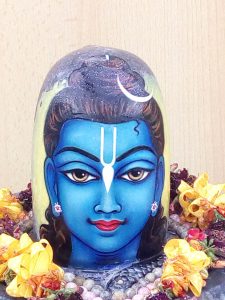
Śrīpāda Āśrama Mahārāja: And they worship him as Gopīśvara Mahādeva.
Śrīla Bhaktivedānta Nārāyaṇa Mahārāja: No. The liṅga may be kept anywhere separate – not in the same temple, unlike Girirāja Govardhana, who can be kept everywhere.

An excerpt from a morning walk with Śrīla Bhaktivedānta Nārāyaṇa Mahārāja in Marina di Massa, Italy, on July 5, 2010, published in Walking with a Saint – Morning Walks and Conversations 2010
Śrīpāda Āśrama Mahārāja: I am asking for a confirmation from yesterday. You said that we should not have a deity of Lord Śiva in the temple. What if it is a śiva-liṅga that is being worshipped as Gopīśvara Mahādeva?
Śrīpāda Śrautī Mahārāja: What about the mūrti of Gopīśvara Mahādeva [in the form of a gopī] at Śrī Rūpa-Sanātana Gauḍīya Maṭha?
Śrīpāda Mādhava Mahārāja: In our Rūpa-Sanātana Maṭha he is not in the form of śiva-liṅga [as in other Lord Śiva temples, such as in Mathurā or the various dhāmas, where Gopīśvara is present and worshipped in the form of śiva-liṅga]. There is no harm in having a picture or mūrti of Gopīśvara in Kṛṣṇa’s temple, but not for official, formal worship.
Śrīla Bhaktivedānta Nārāyaṇa Mahārāja: Gopīśvara Mahādeva is established only in Vṛndāvana.
Śrīpāda Mādhava Mahārāja: His question is: if a śiva-liṅga is kept in a temple and worshipped as Gopīśvara Mahādeva…
Śrīla Bhaktivedānta Nārāyaṇa Mahārāja: Both cannot be kept in one temple. Śiva worship should be kept outside of the temple. Even in Vṛndāvana, he is not present in any Viṣṇu temple. Śaṅkara, Gopīśvara Mahādeva is the gatekeeper of the dhāma.
Śrīpāda Mādhava Mahārāja: In Mathurā there are separate temples of śiva-liṅgas of Bhūteśvara Mahādeva, Gokarṇeśvara Mahādeva, Raṅgeśvara Mahādeva, and Pīppaleśvara Mahādeva.
Śrīla Bhaktivedānta Nārāyaṇa Mahārāja: Without his mercy, no one can enter Vṛndāvana.
Śrīpāda Mādhava Mahārāja: In Vṛndāvana there are temples of Gopīśvara Mahādeva, in Kāmyavana there is Kāmeśvara Mahādeva, and in Govardhana there is Cakaleśvara Mahādeva. In Navadvīpa-dhāma he is also there, and in Purī-dhāma there is Lokanātha Mahādeva.
 The following is an excerpt from a discourse on the glories of Ekādaśī delivered by Śrīla Bhaktivedānta Nārāyaṇa Mahārāja in Los Angeles, California, on June 5, 1998
The following is an excerpt from a discourse on the glories of Ekādaśī delivered by Śrīla Bhaktivedānta Nārāyaṇa Mahārāja in Los Angeles, California, on June 5, 1998
Why was he following Durvāsā? He can fly faster than Durvāsā, so why did he not catch and destroy him? Why 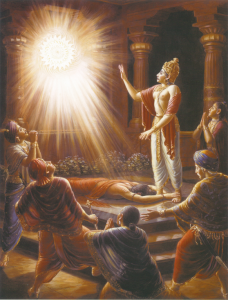 did he only continue chasing him? This is because Durvāsā Muni was actually Śaṅkara, and Śaṅkara is a bhakta. The apparently demonic behaviour of Durvāsā Muni was only to glorify Ambarīṣa Mahārāja. Durvāsā is actually a high-class devotee. He is Śaṅkara. Cakra was following only to make a show, to make a pastime in order to glorify Ambarīṣa Mahārāja and Ekādaśī. Otherwise, even Śaṅkara cannot escape Sudarśana cakra. He could have been burnt. But Śaṅkara is a manifestation of Kṛṣṇa; in Brahmaloka he is Sadāśiva, viṣṇu-tattva. Knowing this Sudarśana cakra only chased him.
did he only continue chasing him? This is because Durvāsā Muni was actually Śaṅkara, and Śaṅkara is a bhakta. The apparently demonic behaviour of Durvāsā Muni was only to glorify Ambarīṣa Mahārāja. Durvāsā is actually a high-class devotee. He is Śaṅkara. Cakra was following only to make a show, to make a pastime in order to glorify Ambarīṣa Mahārāja and Ekādaśī. Otherwise, even Śaṅkara cannot escape Sudarśana cakra. He could have been burnt. But Śaṅkara is a manifestation of Kṛṣṇa; in Brahmaloka he is Sadāśiva, viṣṇu-tattva. Knowing this Sudarśana cakra only chased him.

The following is an excerpt from a discourse on the glories of Śrī Bṛhad-bhāgavatāmṛta delivered by Śrīla Bhaktivedānta Nārāyaṇa Mahārāja in The Netherlands, on July 3, 1997
Śaṅkara is always serving Kṛṣṇa. Narada knows this fact, but he wanted to glorify Śaṅkara so that everyone will know that he is very near and dear – and non-different from Krsna. How? “Sākṣād-dharitvena samasta-śāstrair uktas tathā bhāvyata eva sadbhiḥ kintu prabhor yaḥ priya eva tasya vande guroḥ śrī-caraṇāravindam“. Here sākṣād-dharitvena means priyatvena haritvena. He is very near and dear. “Vaiṣṇavānāṁ yathā śambhuḥ – he is the greatest Vaiṣṇava”.
Śaṅkara-tattva is extremely complex. Brahmā-tattva is not so complicated; he is always jīva-tattva. And sometimes, when there is no qualified jīva, Lord Viṣṇu himself comes as Brahmā. But Śaṅkara is not like this. He is not jīva-tattva. Where does he live? Beyond Brahmaloka. After passing through the eight kinds of material coverings, after crossing the Virajā, Muktidhāma, Mahākālapuram, and then Brahmaloka, there is the planet of Śaṅkara. There he is known as Sadāśiva, and he is viṣṇu-tattva.
For any reason, if something sour is put into milk, it becomes yoghurt. Yoghurt is nothing but milk. It has all the potencies that are in milk, like ghee and so forth, but it is not milk. Milk can become yoghurt, but yoghurt cannot become milk. Śaṅkara is like that. He is not an ordinary jīva. Sometimes, but very rarely, there may be a reason that Sadāśiva cannot come to this world – if he is engaged in his destruction of the universe or anything like that. In that case a qualified jīva can work as Śiva; temporarily, but not permanently. So you should always try to honour Lord Śaṅkara.

The following is an excerpt from Śiva-Tattva: Lord Śiva’s highest benediction by Śrīla Bhaktivedānta Nārāyaṇa Mahārāja
When Śrī Rāmacandra was making the bridge to Laṅkā, He established a Śiva-liṅga (deity form of Śiva) called 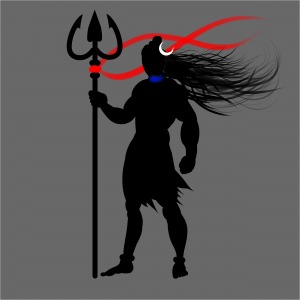 Rāmeśvara. All the common people began glorifying Lord Śiva, shouting, “Rāmeśvara ki jaya! You are Rāma’s īśvara: you are the lord of Rāma.” The demigods were unsatisfied by this and announced through an arial voice, “Rāmas ca asau īśvaraḥ: Rāma is God, and Śaṅkarā is also God; they are the same.” Hearing this, the Śiva-liṅga broke. Lord Śiva emerged from the liṅga and told them all, “You are all foolish; you do not know my tattva, the established truths regarding my identity. Rāma is my beloved and my God, and that is why I am called Rāmeśvara.”
Rāmeśvara. All the common people began glorifying Lord Śiva, shouting, “Rāmeśvara ki jaya! You are Rāma’s īśvara: you are the lord of Rāma.” The demigods were unsatisfied by this and announced through an arial voice, “Rāmas ca asau īśvaraḥ: Rāma is God, and Śaṅkarā is also God; they are the same.” Hearing this, the Śiva-liṅga broke. Lord Śiva emerged from the liṅga and told them all, “You are all foolish; you do not know my tattva, the established truths regarding my identity. Rāma is my beloved and my God, and that is why I am called Rāmeśvara.”
Lord Śiva eternally resides in Lord Kṛṣṇa’s abode, Vṛndāvana, where he manifests many forms to render devotional services to Him. The form of Gopīśvara Mahādeva* was manifested by Lord Kṛṣṇa’s desire. When Kṛṣṇa desired to perform His rāsa dance, Śrīmatī Rādhikā, the embodiment of His pleasure potency, manifested from His left side and Gopīśvara Mahādeva manifested from His right side. The form of Śiva who lives in Kāśī or Kailāsa in the material world is a partial manifestation of the original Sadāśiva in Vṛndāvana. The many other commonly worshipped forms of Lord Śiva are expansions of Sadāśiva. They are not the original. Partial expansions such as Pīppaleśvara Mahādeva, Bhūteśvara Mahādeva, Raṅgeśvara Mahādeva and so on cannot award the benediction that can be attained by the mercy of Gopīśvara – the highest perfection of love, namely gopī-prema.
Śrīla Raghunātha dāsa Gosvāmī has composed a prayer in his Vraja-vilāsa-stava:
mudā gopendrasyātmaja-bhuja-pariṣvaṅga-nidhaye
sphurad-gopī-vṛndair yam iha bhagavantaṁ praṇayibhiḥ
bhajadbhis tair bhaktyā svam abhilaṣitaṁ prāptam acirād
yamī-tīre gopīśvaram anudinaṁ taṁ kila bhaje
I daily worship Gopīśvara Mahādeva, who is situated on the bank of Yamunā. That very Gopīśvara was worshipped with deep devotion by the gopīs, and he quickly fulfilled their desire to attain a supremely precious jewel in the form of the embrace of the son of Nanda Mahārāja [Kṛṣṇa].
Śrīla Sanātana Gosvāmī, the great Vaiṣṇava saint who resided in Vṛndāvana near the old Śrī Madana-Mohana 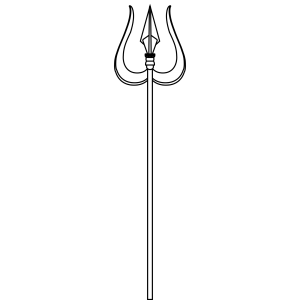 Temple, would go daily to see Śrī Gopīśvara Mahādeva at his temple. Once, in his older years, Sanātana Gosvāmī had a dream wherein Gopīśvara Mahādeva appeared and instructed him: “Now that you are old, please do not go through so much trouble to see me.” Sanātana Gosvāmī replied, “I will continue to come. I cannot change this habit.” Gopīśvara Mahādeva said, “Then I will come and stay very near to your residence, manifesting in Bankhandī.” The very next day, Śrī Gopīśvara Mahādeva appeared in Bankhandī, halfway between his original temple and Śrīla Sanātana Gosvāmī’s residence. Seeing this, Sanātana Gosvāmī became overwhelmed with transcendental ecstasy, and from that day on he visited Bankhandī Mahādeva every day.
Temple, would go daily to see Śrī Gopīśvara Mahādeva at his temple. Once, in his older years, Sanātana Gosvāmī had a dream wherein Gopīśvara Mahādeva appeared and instructed him: “Now that you are old, please do not go through so much trouble to see me.” Sanātana Gosvāmī replied, “I will continue to come. I cannot change this habit.” Gopīśvara Mahādeva said, “Then I will come and stay very near to your residence, manifesting in Bankhandī.” The very next day, Śrī Gopīśvara Mahādeva appeared in Bankhandī, halfway between his original temple and Śrīla Sanātana Gosvāmī’s residence. Seeing this, Sanātana Gosvāmī became overwhelmed with transcendental ecstasy, and from that day on he visited Bankhandī Mahādeva every day.
Wherever he was, Śrīla Sanātana Gosvāmī could not live without his beloved Lord Śiva – Gopīśvara Mahādeva and Bankhandī Mahādeva in Vṛndāvana, and Kāmeśvara Mahādeva in Kāmyavana forest. In Govardhana he would stay near his very dear friend, Cakreśvara Mahādeva, who acquired the name when he served Govardhana Hill and the Vrajavāsīs by holding up his trident like a cakra (disc weapon), protecting them from the torrential deluge sent by King Indra.
Prior to this, Lord Śiva had asked Śrī Kṛṣṇa for the boon to witness His childhood pastimes. Kṛṣṇa ordered him  to situate himself in Nandagaon in the form of a hill. Śiva followed this order and became Nandīśvara Hill, and he thus became known as Nandīśvara. (Lord Brahmā became Brahma-parvata, the mountain in Śrīmatī Rādhikā’s birthplace, Varṣāṇā. Because Brahmā is so near to Rādhikā, he is also our Gurudeva.)
to situate himself in Nandagaon in the form of a hill. Śiva followed this order and became Nandīśvara Hill, and he thus became known as Nandīśvara. (Lord Brahmā became Brahma-parvata, the mountain in Śrīmatī Rādhikā’s birthplace, Varṣāṇā. Because Brahmā is so near to Rādhikā, he is also our Gurudeva.)
We honour Lord Śiva as a great Vaiṣṇava and as Guru. We do not worship him separately. We observe Śiva-rātri, Lord Śiva’s appearance day, and we glorify him in connection to his relationship with Śrī Kṛṣṇa. Śrīla Sanātana Gosvāmī has written in his Hari-bhakti-vilāsa that all Vaiṣṇavas should observe Śiva-caturdaśī (Śiva-rātri). Lord Śiva, in whom all good qualities reside, should certainly be honoured by the observance of this day.
We offer obeisance to Lord Śiva with prayers like this:
vṛndāvanāvani-pate! jaya soma soma-maule
sanaka-sanandana-sanātana-nāradeḍya
gopīśvara! vraja-vilāsi-yugāṅghri-padme
prema prayaccha nirupādhi namo namas te
(Saṅkalpa-kalpadruma 103)
O Gatekeeper of Vṛndāvana! O Soma, all glories to you! O you whose forehead is decorated with the moon, and who is worshipable by the sages headed by Sanaka, Sanandana, Sanātana and Nārada! O Gopīśvara! Desiring that you bestow upon me prema for the lotus feet of Śrī Śrī Rādhā-Mādhava, who perform joyous pastimes in Vrajadhāma, I offer obeisances unto you time and again.
*In his original and most pure form, Śiva is eternally Gopīśvara Mahadeva. Yet, he performed the following 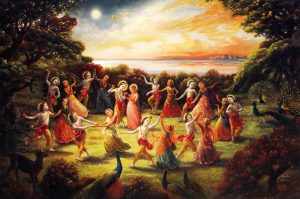 human-like pastime in which he ‘became’ Gopīśvara:
human-like pastime in which he ‘became’ Gopīśvara:
“Lord Śiva wanted to become a gopī. He performed austerities, and when Paurṇamāsī Yogamāyā became pleased and appeared before him, he prayed to join Kṛṣṇa’s rāsa-lila. Paurṇamāsī mercifully assisted him in dipping in Brahmā-kuṇḍa, and he immediately assumed the form of a teenage gopī. He then went to the place where rāsa-lila was being performed and hid there in a grove.
“Kṛṣṇa and the gopīs sensed that someone of a different mood had come. They asked each other, ‘Why are you not so happy today? What is the matter?’ After searching, they discovered the new gopī and asked ‘her’, ‘Who are you? What is your name? Who are your parents? What is your husband’s name? Where is your in-laws’ house?’
“When Śiva could not reply, they began to slap her so much that her cheeks became swollen and she began to cry, ‘Yogamāyā, Yogamāyā. Save me. I will never again come to Vṛndāvana, and I will never dare take part in rāsa-līlā.’ Paurṇamāsī arrived, and she requested the gopīs to show Lord Śiva mercy. ‘She is the object of my mercy,’ Paurṇamāsī told them. The gopīs then accepted her as a gopī and Kṛṣṇa named her Gopīśvara (she whose īśvaras, controllers, are the gopīs). He blessed her to become the guard of the rāsa-līlā and said, ‘Without the sanction of Gopīśvara, no one will be able to enter the rāsa-līlā.’ ” (Pinnacle of Devotion)

Chapter 2 from the book, Going Beyond Vaikuṇṭha, 4th edition by Śrīla Bhaktivedānta Nārāyaṇa Mahārāja
Gopa-kumāra appeared the same as before, but at this time he shed his material form and assumed a purely spiritual form. Now like electricity he crossed in one minute the eight material coverings that before had taken him millions of years to cross step by step. The denizens of the heavenly planets showered flowers on him as he passed by at great speed, and Lord Brahmā and others offered obeisances to him. Crossing those eight coverings he saw whatever happiness was available inside them, and then crossing the Virajā he arrived in Śivaloka.
Brahmaloka consists of two sections: the upper part is called Sadāśivaloka, and the lower part is Siddhaloka, which is the destination given to the demons who are personally killed by Bhagavān. The impersonalists also attain this destination after meditating on the formless light for millions of years. That is called sāyujya-mukti. This lower part is also called Mahākālapuram or Sāyujyaloka by the sages. This Mahākālapuram is where Kṛṣṇa took Arjuna to retrieve the son of the brāhmaṇa.*
When Gopa-kumāra was at this Siddhaloka, he saw that it was like a very deep river where one remains submerged in Brahman for some time and then rises up again. By chanting his gopāla-mantra he would come up, but then by the influence of the lower world he would again be submerged. Looking upon this formless void with abhorrence, he proceeded up from Siddhaloka to Sadāśivaloka. There Śaṅkara and Pārvatī were performing kīrtana and dancing with their associates. Pārvatī is also known as Gaurī, she who possesses a bright bodily complexion. Her limbs were shining like pure camphor and making her appear very beautiful. She 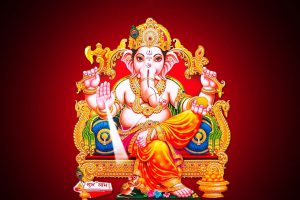 was playing some musical instruments and Śaṅkara was dancing. Gaṇeśa was singing, and Kārttikeya, Nandī, Bhṛṅgī and all of their associates were present there, glorifying Bhagavān and dancing. At that time Gaṇeśa told Gopa-kumāra that Śaṅkara and Bhagavān are one and the same, non-different. After some time, Gopa-kumāra looked up into the sky and saw four people there performing kīrtana. They were eternal residents of Vaikuṇṭha. Seeing Śiva and Pārvatī, they offered obeisances and said, “O Mahādeva, you and Hari are the same Soul.”
was playing some musical instruments and Śaṅkara was dancing. Gaṇeśa was singing, and Kārttikeya, Nandī, Bhṛṅgī and all of their associates were present there, glorifying Bhagavān and dancing. At that time Gaṇeśa told Gopa-kumāra that Śaṅkara and Bhagavān are one and the same, non-different. After some time, Gopa-kumāra looked up into the sky and saw four people there performing kīrtana. They were eternal residents of Vaikuṇṭha. Seeing Śiva and Pārvatī, they offered obeisances and said, “O Mahādeva, you and Hari are the same Soul.”
Hearing this, Śiva put his hands over his ears and said, “What are you saying? You don’t know any tattva. Me – the īśvara? No, I am not Īśvara, I am the servant of Īśvara, the servant of Nārāyaṇa.”
After those four residents of Vaikuṇṭha elucidated some tattva, Śiva began speaking to Gopa-kumāra: “Who can go to Vaikuṇṭha? After one hundred births of giving charity, performing pious activities, and following varṇāśrama-dharma perfectly, one attains the position of Brahmā. Then, by performing the function of Brahmā well for one hundred births, one becomes Śiva. After assuming the post of Śiva for thousands of years, one becomes a Vaiṣṇava. I also desire to become a Vaiṣṇava. Then, by practising sādhana-bhakti as a Vaiṣṇava, one attains Vaikuṇṭha. Therefore attaining Vaikuṇṭha is not easy; it is very rare. It appears that you are ready to enter Vaikuṇṭha, but you cannot go straight there from here; there is no direct path. From here go to Vraja, engage in some bhajana and sādhana, and then you can go there.”
* This pastime is narrated in Śrīmad-Bhāgavatam, Tenth Canto, Chapter 89.

The following is an excerpt from Śiva-Tattva: The Post and the Person by Śrīla Bhaktivedānta Nārāyaṇa Mahārāja
However, Prahlāda Mahārāja cannot enter Śrī Kṛṣṇa’s transcendental abode, Vṛndāvana, whereas Lord Śiva resides there eternally as Gopīśvara. Śiva serves Śrī Kṛṣṇa personally in numerous ways. He and his wife Pārvatī-devī meditate on aṣṭa-kālīya-līlā, Lord Śrī Kṛṣṇa’s confidential eight-fold daily pastimes. These secret pastimes are very confidential, yet both Śiva and Pārvatī are able to meditate upon them. Śiva is hundreds of thousands of times superior to and more worshipable than Śrī Prahlāda Mahārāja, and yet the artful Śiva declared Prahlāda Mahārāja to be superior. Why did he do so? In one sense Prahlāda Mahārāja is superior, and in another sense he is not.
We can reconcile this by considering the two perspectives from which to understand the identity of Lord Śiva: We can see Śiva from the point of view of his post, and also from the point of view of his personality. As a personality, separate from his post, he appears as an associate of the Supreme Lord, such as Gopīśvara, Hanumān and Bhīma. As Gopīśvara he resides eternally in Vṛndāvana. As Hanumān he always associates with and serves Lord Rāma. As Bhīma he always serves Lord Kṛṣṇa. And, when Hanumān and Bhīma combine together in this present age of Kali-yuga, they become Madhvācārya, our Sampradāya-guru.*
From the point of view of Lord Śiva’s function as the god of annihilation, and also that of Brahmā as the secondary creator of the universe, Śiva and Brahmā are actually posts. Lord Brahmā and Lord Śiva are not ordinary human beings, but their posts are like that of the president or prime minister of a nation, wherein the man representing the post has to perform a certain defined job.
Both as the post and the person, Śiva is superior to Brahmā. Lord Śiva is an expansion of Lord Viṣṇu, but sometimes a jīva (living entity) may become Śiva’s expansion known as Rudra. If a man purely performs the duties of varṇāśrama for one hundred births, he may become Brahmā.** In other words, he may attain the position or post of Brahmā. In turn, when a person in the post of Brahmā carries out his function expertly for one hundred births, he becomes qualified to perform the function of Śiva in his manifestation as Rudra. Śiva’s post is therefore superior to that of Brahmā, and this is also evidence that Śiva is more powerful than Brahmā.
What is the function of Lord Śiva’s post, and why is it superior to that of Lord Brahmā? One reason is that Brahmā cannot execute pralaya, the complete destruction of the universe – a very dangerous thing, whereas Śiva can do so.
Śiva’s function as destroyer is similar to that of a farmer who plants and cultivates a large area of wheat. The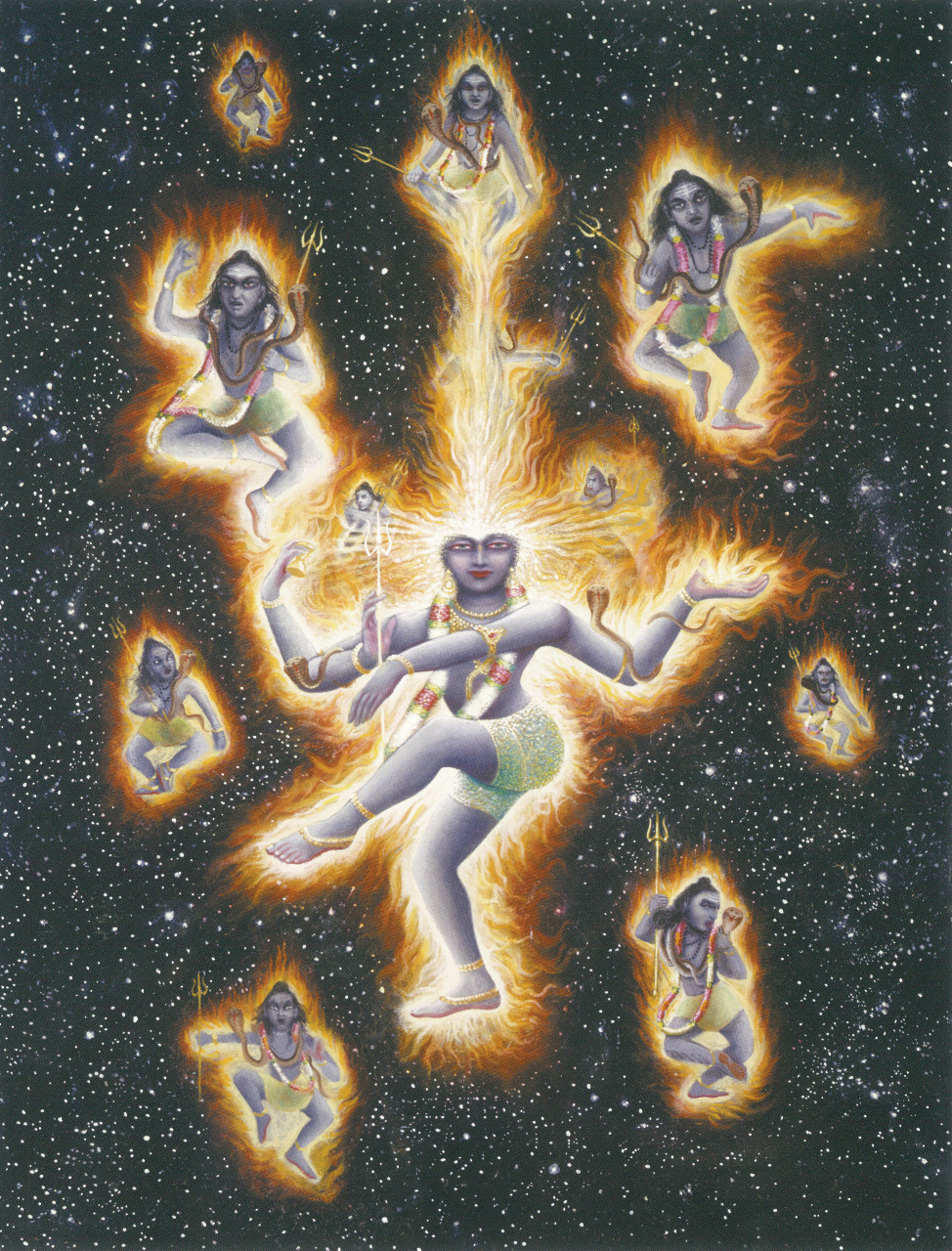 farmer carefully waters and nourishes the crop, guarding it against animals, and after five or six months the wheat matures and ripens. Then, either by hand or a machine, the farmer harvests the plants and carefully removes the grains from their shafts. The rest of the plant matter becomes refuse and is subject to rotting and attracting disease, vermin, and snakes. Therefore, the farmer sets fire to it and burns it.
farmer carefully waters and nourishes the crop, guarding it against animals, and after five or six months the wheat matures and ripens. Then, either by hand or a machine, the farmer harvests the plants and carefully removes the grains from their shafts. The rest of the plant matter becomes refuse and is subject to rotting and attracting disease, vermin, and snakes. Therefore, the farmer sets fire to it and burns it.
Just as the farmer extracts the grains from the plants, Lord Śiva extracts the eternal spirit souls from their material bodies and from the world. At the time of annihilation he creates an inferno, setting the entire universe on fire, but the spirit souls are not destroyed.
There are two kinds of universal devastations: one at the end of Lord Brahmā’s day and one at the end of his life. At the end of his day (4,320,000,000 solar years) he rests in a mystic sleep within the body of Garbhodakaśāyī Viṣṇu, and all the conditioned living entities enter as well.***
While the entire universe is submerged in water, the living entities rest in their subtle bodies within the transcendental body of Garbhodakaśāyī Viṣṇu. They await the start of the next day of Brahmā, the next material creation or manifestation. Some of them become liberated, and others do not.
When Lord Brahmā completes the one hundred celestial years of his life, Lord Śiva again performs this duty of destruction. At that time all the spirit souls enter into the body of Kāraṇodakaśāyī Viṣṇu or Mahā-Viṣṇu. At the end of each day of Lord Brahmā, all souls enter Garbhodakaśāyī Viṣṇu, and at the end of Brahmā’s life, even the millions of manifestations of Garbhodakaśāyī Viṣṇu enter Kāraṇodakaśāyī Viṣṇu**** along with the spirit souls. At the time of creation, Kāraṇodakaśāyī Viṣṇu generates innumerable manifestations of Garbhodakaśāyī Viṣṇu, and at the time of complete annihilation, they enter back into his body.*****
Lord Śiva is not a living entity, but he is also not in the category of Lord Viṣṇu. He is much more powerful than any living entity, even up to Lord Brahmā. However, he is not equal to Lord Viṣṇu. Because he is almost as good as the Supreme Personality of Godhead, he can see the three phases of time: past, present and future. One of his eyes is like the sun and another is like the moon. He also has a third eye, located between his eyebrows. It is from this third eye that he generates fire and employs it at the time of the universal destruction.
Seen from this perspective – the destroyer – Lord Śiva cannot serve Śrī Kṛṣṇa directly, because he is engaged at his post. Those souls who are liberated after hundreds of thousands of lifetimes of devotional practice, having renounced all responsibilities and concerns of the world – including occupations like that of Brahmā and Śiva – and who constantly hear about, glorify, and remember Lord Kṛṣṇa, take birth in this world as pure devotees like Prahlāda Mahārāja. This was told by Lord Śiva to Śrī Nārada.
* “Śrīla Madhvācārya is the original ācārya for those who belong to the Madhva Gauḍīya-sampradāya.”(SB 6.1.40 purport) “This Madhva-Gauḍīya-sampradāya is also known as the Brahmā-sampradāya because the disciplic succession originally began from Brahmā. Brahmā instructed the sage Nārada, Nārada instructed Vyāsadeva, and Vyāsadeva instructed Madhva Muni, or Madhvācārya.” (Kṛṣṇa Introduction).
** “The Vedas say, ‘Svadharma-niṣṭhaḥ śata janmabhiḥ pumān viriñcatām eti – One who strictly follows the 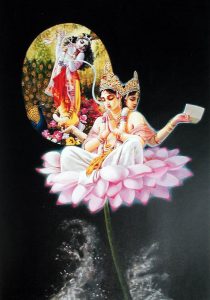 principles of varṇāśrama-dharma for at least one hundred births will be rewarded with the post of Lord Brahmā.’ ” (Śrīmad-Bhāgavatam 5.20.33 purport) Varṇāśrama-dharma – the institutions dividing society into four divisions of social life and four occupational divisions of castes.
principles of varṇāśrama-dharma for at least one hundred births will be rewarded with the post of Lord Brahmā.’ ” (Śrīmad-Bhāgavatam 5.20.33 purport) Varṇāśrama-dharma – the institutions dividing society into four divisions of social life and four occupational divisions of castes.
*** “At the beginning of Brahmā’s day, all living entities become manifest from the unmanifest state, and thereafter, when the night falls, they are merged into the unmanifest again. Again and again, when Brahmā’s day arrives, all living entities come into being, and with the arrival of Brahmā’s night they are helplessly annihilated.” (Bhagavad-gītā 8.18-19)
“At the end of the day, under the insignificant portion of the mode of darkness, the powerful manifestation of the universe merges in the darkness of night. By the influence of eternal time, the innumerable living entities remain merged in that dissolution, and everything is silent.” (Śrīmad-Bhāgavatam 3.11.28)
“The dissolution of the three worlds is effected by the incarnation of darkness, Rudra, represented by the fire of eternal time which blazes over the three worlds.
These three worlds are known as Bhūḥ, Bhuvaḥ and Svaḥ (Pātāla, Martya and Svarga). The innumerable living entities merge into that dissolution, which appears to be the dropping of the curtain of the scene of the Supreme Lord’s energy, and so everything becomes silent.” (Śrīmad-Bhāgavatam 3.11.28 purport)
“It is said that the blazing fire from the mouth of Saṅkarṣaṇa rages for one hundred years of the demigods, or 36,000 human years. Then for another 36,000 years there are torrents of rain, accompanied by violent winds and waves, and the seas and oceans overflow. People forget all these devastations of the worlds and think themselves happy in the material progress of civilization. This is called māyā, or ‘that which is not.’” (Śrīmad-Bhāgavatam 11.31 purport)
“Thereafter, at the end of the millennium, the Lord Himself, in the form of Rudra, the destroyer, will annihilate the complete creation as the wind displaces the clouds. This creation is very appropriately compared to clouds.” (Śrīmad-Bhāgavatam 2.10.43)
**** “There are two types of dissolution of the manifested cosmos. At the end of every 4,320,000,000 solar years, when Brahmā, the lord of one particular universe, goes to sleep, there is one annihilation. And at the end of Lord Brahmā’s life, which takes place at the end of Brahmā’s one hundred years of age, in our calculation at the end of 8,640,000,000 x 30 x 12 x 100 solar years, there is complete annihilation of the entire universe, and in both the periods both the material energy called the mahat-tattva and the marginal energy called jīva-tattva merge in the person of the Supreme Lord.” (Śrīmad-Bhāgavatam 10.21 purport)
***** “Kāraṇodakaśāyī Viṣṇu is the first incarnation of the Supreme Lord, and He is the master of eternal time, space, cause and effects, mind, the elements, the material ego, the modes of nature, the senses, the universal form of the Lord, Garbhodakaśāyī Viṣṇu, and the sum total of all living beings, both moving and nonmoving.” (Śrīmad-Bhāgavatam 6.4)
 The following is an excerpt from a lecture on Śrīmad-Bhāgavatam 9.9.7 by Śrīla Gaura Govinda Svāmī Mahārāja in Bhubaneswar, India on February 16, 1994, published in Sri Krishna Kathamrita 07: The Greatest Vaishnava by Gopaljiu Publications (https://gopaljiu.org/archive/)
The following is an excerpt from a lecture on Śrīmad-Bhāgavatam 9.9.7 by Śrīla Gaura Govinda Svāmī Mahārāja in Bhubaneswar, India on February 16, 1994, published in Sri Krishna Kathamrita 07: The Greatest Vaishnava by Gopaljiu Publications (https://gopaljiu.org/archive/)
If some occasion arises to offer worship to Śiva, a Vaiṣṇava offers worship to Viṣṇu or Kṛṣṇa in the mūrti of Śiva, because there is no difference between them, “priyasya sakhyuh”. One example of this is found in Viṣṇu-dharmottara (Cited by Śrīla Jīva Gosvāmī in his Bhakti-sandarbha, anucheda 106):
There was a very dear parama bhāgavata devotee of Lord Viṣṇu named Viśvaksena. He was travelling throughout the world. Once, feeling tired, he sat down in a forest. There was a village close by. The son of the village chief happened to come by. Seeing the brāhmaṇa Viśvaksena, he said, “I am the son of the village chief. I have a very bad headache today so I cannot offer worship to my iṣṭa, Śivajī. So I request you, please offer worship to Śivajī today on my behalf.”
Viśvaksena said, “I am a viṣṇu-bhakta, I am a dear devotee of Viṣṇu. I only offer worship to Kṛṣṇa and His forms such as Viṣṇu, Vāsudeva, Saṅkarṣaṇa, Pradyumna and Aniruddha. I never offer worship to demigods. I never offer worship to anyone else. You may go elsewhere.”
The son of the village chief became angry and drew his sword, “If you do not obey me, if you do not worship my iṣṭa, Śiva, on my behalf, then I will cut off your head.”
In order to save himself from death, Viśvaksena said, “Yes, yes, I will worship, I will worship.” He thought to himself that Śiva is Rudradeva, the incarnation of ignorance, tamo-guṇa. As Śrīla Prabhupāda writes in the purport to Bhāgavatam 9.9.7 [see the beginning of this lecture]:
The material world exists predominantly in the mode of ignorance. Therefore Lord Śiva is compared here to the longitude and latitude of the entire universe, which resembles a cloth woven of threads extending for both its length and breadth.
Rudra is the incarnation of tamo-guṇa and Nṛsiṁhadeva is the killer of the demons, in whom tamo-guṇa is 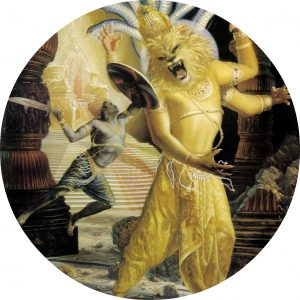 predominating. So Viśvaksena thought, “I must worship Nṛsiṁhadeva in the Śiva mūrti to kill this person’s tamo-guṇa.” So uttering the mantra, “śrī nṛsiṁhāya namaḥ” — “I offer my obeisances to Lord Nṛsiṁhadeva” — he offered flowers to the Śiva deity. When the son of the village chief heard him chant that mantra he got angry and drew out his sword to cut off his head, “What are you doing? You are uttering nṛsiṁha-mantra? You are not worshipping my iṣṭa, Śiva!” When that person drew his sword to cut off Viśvaksena’s head, immediately Nṛsiṁhadeva appeared from the Śiva mūrti and cut off the head of that person and all of his family members. All were finished.
predominating. So Viśvaksena thought, “I must worship Nṛsiṁhadeva in the Śiva mūrti to kill this person’s tamo-guṇa.” So uttering the mantra, “śrī nṛsiṁhāya namaḥ” — “I offer my obeisances to Lord Nṛsiṁhadeva” — he offered flowers to the Śiva deity. When the son of the village chief heard him chant that mantra he got angry and drew out his sword to cut off his head, “What are you doing? You are uttering nṛsiṁha-mantra? You are not worshipping my iṣṭa, Śiva!” When that person drew his sword to cut off Viśvaksena’s head, immediately Nṛsiṁhadeva appeared from the Śiva mūrti and cut off the head of that person and all of his family members. All were finished.
So where is the difference between Śiva and Viṣṇu? This śiva–liṅga that Lord Nṛsiṁha came out of is there in South India. It is known as Liṅga-sphoṭa. You may go and see it

The following is an excerpt from a discourse on the glories of Prauḍhā Māyā delivered by Śrīla Bhaktivedānta Nārāyaṇa Mahārāja in Śrī Navadvīpa-dhāma, India, on March 24, 2002
Śiva means auspicious. Śiva deludes those who are averse to Kṛṣṇa, and he is favourable to and helps those who are His devotees. Śaṅkara-tattva or Śiva-tattva is very complex. He is not Viṣṇu, nor is he a jīva.* He is not māyā-tattva, but he is not beyond māyā-tattva. As Sadāśiva he is viṣṇu-tattva. As viṣṇu-tattva he is svāṁśa, a plenary portion of Krsna. Also, when Kṛṣṇa incarnates in the three modes of nature, Śiva is the predominating deity of tamo-guṇa, the mode of ignorance. Brahma-saṁhitā states that Śiva is a combination of tamo-guṇa, the quality of minuteness of the marginal potency, and a minute degree of the mixture of samvit and hlādinī.
*Note from the editor: In some kalpa but very rarely, there may be a reason that Sadāśiva cannot come to this world. In that case a qualified jīva can work as Śiva; temporarily, but not permanently. The śloka below therefore explains that one should not consider this jīva who has the post of Śiva to be equal to Viṣṇu.
yas tu nārāyaṇaṁ devaṁ
brahma-rudrādi-daivataiḥ
samatvenaiva vīkṣeta
sa pāṣaṇḍī bhaved dhruvam”
Śrī Caitanya-caritāmṛta, Madhya-līlā 25.80
“ ‘A person who considers demigods like Brahmā and Śiva to be on an equal level with Nārāyaṇa is to be considered an offender, a pāṣaṇḍī.
The standard for Ekādaśī break-fasts
If you have observed a complete fast (without even water) you do not need to break it with grains. You can break it with caranāmṛta or fruit. But if you have observed Ekādaśī by eating fruit, vegetables, etc., then it should be broken on the following day by taking grains at the times mentioned herein.
Mahā-dvādaśi is observed like Ekādaśī.
Ekādaśī
The essence is to eat simply, once or twice, so that one can spend as much time as possible hearing, chanting and remembering Śrī Śrī Rādhā-Kṛṣṇa. Never eat meat, fish, eggs, onions, garlic, carrots, red lentils (masūr-dal), green flat lentils, mushrooms or products thereof.
- Restricted foods on Ekādaśī:

- Tomatoes, eggplants, cauliflower, broccoli, bell peppers, beets, bitter melon (karela), loki, parmal, toroi, kunli, drumsticks, bindī (ladies’ fingers) and banana flowers
- Peas, chickpeas and all types of beans, including products made from beans (e.g., papadams, tofu, tempeh)
- All leafy vegetables (e.g., spinach, salads, cabbages) and leafy herbs like parsley, coriander leaves, celery and curry leaves
- Grains (e.g., millet, barley, farina, pasta, rice, corn) and all types of flour made from grains and beans (e.g., rice flour, chickpea flour, urad dahl flour)
- Starches from corn or grains, and products made from or mixed with these starches like baking soda, baking powder, certain soft drinks with corn syrup, custard, certain yoghurts and puddings, certain varieties of cream and cottage cheese, certain sweets and candies, and tapioca balls
- Oils made from grains (e.g., corn oil, mustard oil, sesame oil) and products fried in these oils (e.g., fried nuts, potato chips and other fried snack foods)
- Honey, and sweets made with starches
- Spices used on Ekādaśī: black pepper, fresh ginger, pure salt and fresh turmeric, all taken from a new and clean package
- Spices not used on Ekādaśī: hing (asafoetida), sesame seeds, cumin, fenugreek, mustard, tamarind, fennel, cardamom and nutmeg
- Foods that can be taken all days of the year, including Ekādaśī and Cāturmāsya:
- All fruits (fresh and dried), all nuts and all oils made from nuts
- Potatoes, pumpkin, cucumber, radish, squash, lemon, avocado, olives, coconut, buckwheat, all sugars
- All pure milk products (except yoghurt during the 2nd month of Cāturmāsya and milk during the 3rd month)
- For sannyāsīs, brahmacārīs and vānaprasthas: shaving head and cutting nails is to be done on full moon days
Cāturmāsya
- Restricted foods during the entire four months of Cāturmāsya:
- Eggplants, tomatoes, loki, parmal, urad dahl and honey
- Particular foods that are restricted during each of the four months:
- First month: No leafy vegetables, such as spinach, salads of all types, cabbages of all types, kale, leafy herbs like coriander, mint, parsley, curry and powdered leafy herbs and teas
- Second month: No yoghurt (if one requires it for health, it can be mixed with water)
- Third month: No milk (if required, it can be mixed with a drop of lemon juice)
- Fourth month: No mustard oil or sesame seeds
Puruṣottama Māsa
- Restricted foods during the month of Puruṣottama:
- Eggplants, tomatoes, loki, parmal, urad dahl, honey, mustard oil or sesame seeds
- No shaving for brahmacārīs and sannyāsīs
Source: Purebhakti.com
Image/Art made possible by Pixabay.com, Krishnapath.org and/or Bhaktiart.net
Unless indicated differently, all verse translations and quotes are from the books by Śrīla Bhaktivedānta Svāmī Mahārāja Prabhupāda (Vedabase.com)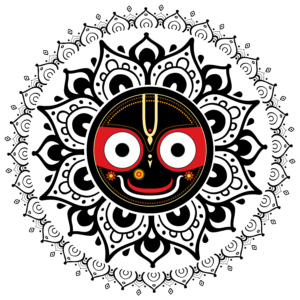



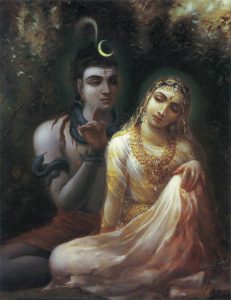 and Lord Śiva, who are known as permanent governors. Therefore there is also no counting them. “Once, when Kṛṣṇa was ruling Dvārakā, Lord Brahmā came to see Him, and the doorman immediately informed Lord Kṛṣṇa of Brahmā’s arrival. When Kṛṣṇa was so informed, He immediately asked the doorman, ‘Which Brahmā? What is his name?’ The doorman therefore returned and questioned Lord Brahmā. “When the doorman asked, ‘Which Brahmā?’ Lord Brahmā was surprised. He told the doorman, ‘Please go inform Lord Kṛṣṇa that I am the four-headed Brahmā who is the father of the four Kumāras.’ “The doorman then informed Lord Kṛṣṇa of Lord Brahmā’s description, and Lord Kṛṣṇa gave him permission to enter. The doorman escorted Lord Brahmā in, and as soon as Brahmā saw Lord Kṛṣṇa, he offered obeisances at His lotus feet. “After being worshipped by Lord Brahmā, Lord Kṛṣṇa also honoured him with suitable words. Then Lord Kṛṣṇa asked him, ‘Why have you come here?’
and Lord Śiva, who are known as permanent governors. Therefore there is also no counting them. “Once, when Kṛṣṇa was ruling Dvārakā, Lord Brahmā came to see Him, and the doorman immediately informed Lord Kṛṣṇa of Brahmā’s arrival. When Kṛṣṇa was so informed, He immediately asked the doorman, ‘Which Brahmā? What is his name?’ The doorman therefore returned and questioned Lord Brahmā. “When the doorman asked, ‘Which Brahmā?’ Lord Brahmā was surprised. He told the doorman, ‘Please go inform Lord Kṛṣṇa that I am the four-headed Brahmā who is the father of the four Kumāras.’ “The doorman then informed Lord Kṛṣṇa of Lord Brahmā’s description, and Lord Kṛṣṇa gave him permission to enter. The doorman escorted Lord Brahmā in, and as soon as Brahmā saw Lord Kṛṣṇa, he offered obeisances at His lotus feet. “After being worshipped by Lord Brahmā, Lord Kṛṣṇa also honoured him with suitable words. Then Lord Kṛṣṇa asked him, ‘Why have you come here?’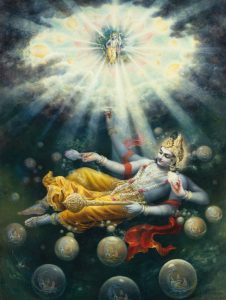 universes. Consequently you have only four heads. “ ‘Some of the universes are one billion yojanas in diameter, some one trillion, some ten trillion and some one hundred trillion yojanas. Thus they are almost unlimited in area. “ ‘According to the size of the universe, there are so many heads on the body of Brahmā. In this way I maintain innumerable universes [brahmāṇḍas]. ‘No one can measure the length and breadth of the one-fourth of My energy manifested in the material world. Who then can measure the three-fourths that is manifested in the spiritual world?’ “ ‘Beyond the river Virajā is the spiritual nature, which is indestructible, eternal, inexhaustible and unlimited. It is the supreme abode, consisting of three-fourths of the Lord’s opulences. It is known as paravyoma, the spiritual sky.”’ “In this way Lord Kṛṣṇa bade farewell to the four-headed Brahmā of this universe. We may thus understand that no one can calculate the extent of Kṛṣṇa’s energies.
universes. Consequently you have only four heads. “ ‘Some of the universes are one billion yojanas in diameter, some one trillion, some ten trillion and some one hundred trillion yojanas. Thus they are almost unlimited in area. “ ‘According to the size of the universe, there are so many heads on the body of Brahmā. In this way I maintain innumerable universes [brahmāṇḍas]. ‘No one can measure the length and breadth of the one-fourth of My energy manifested in the material world. Who then can measure the three-fourths that is manifested in the spiritual world?’ “ ‘Beyond the river Virajā is the spiritual nature, which is indestructible, eternal, inexhaustible and unlimited. It is the supreme abode, consisting of three-fourths of the Lord’s opulences. It is known as paravyoma, the spiritual sky.”’ “In this way Lord Kṛṣṇa bade farewell to the four-headed Brahmā of this universe. We may thus understand that no one can calculate the extent of Kṛṣṇa’s energies.




